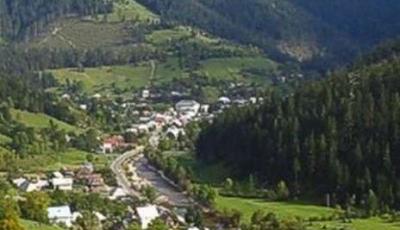Albac
Albac (Hungarian Fehérvölgy or Albak ) is a town in Alba county in Transylvania, Romania.
Location
The community consists of 16 villages with a total of about 2000 inhabitants and covers an area of 5389 hectares. 96 km from the county capital Alba Iulia and 19 kilometers from Câmpeni, along the National Road ( Drum National) DN 75 ( Câmpeni - Nucet, Kr Bihor ), is the village in Apuseni Mountains at the mouth of the river Arada in the ARIESUL Mare, a swelling flow of Aries.
History
According to a report by G. Téglás from 1889 ancient traces have been found of gold-washing on site. The place was documented for the first time under the name of Raul Mare in 1733 as a community with several villages. In a description from 1782 and two big towns are mentioned by seven and four churches and 153 landlords. With a growing population is Albac became an independent municipality.
The wooden church Sf. Pantelimon built in 1746 by Vasile Ursu Nicola Albac (also called Horea ), was dismantled and re-erected in 1907 in the spa town of Băile Olăneşti ( Kr Vâlcea ).
The residents now live mainly from agriculture, animal husbandry, fruit growing and working in the quarry.
Population
1850 lived on the territory of the present town of 3547 inhabitants. 3540 were Romanians and seven Roma. 1900 was registered with 5805 the largest population. As of the 2002 census lived in Albac 2220 people, including 2182 Romanians, a Hungarian and 37 Roma.
Attractions
- The Romanian Orthodox Church, built 1880-1884. 1884 collapsed the tower, it was built from 1891 to 1892 and again in 1943 to its original form.
- The Village Museum
- The bust Horeas (1731-1785), leader of the peasant uprising in 1784 in the center of the village, was built in 1967 and is a listed building.
Pictures
Entrance to the village Albac
Resting place after the entrance to the village Albac
The wooden church Sf. Pantelimon, is in Olăneşti







